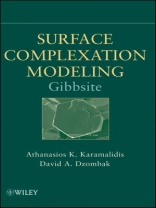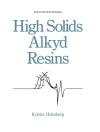This book provides a description of the generalized two layer
surface complexation model, data treatment procedures, and
thermodynamic constants for sorption of metal cations and anions on
gibbsite, the most common form of aluminum oxide found in nature
and one of the most abundant minerals in soils, sediments, and
natural waters. The book provides a synopsis of aluminum oxide
forms and a clearly defined nomenclature. Compilations of available
data for sorption of metal cations and anions on gibbsite are
presented, and the results of surface complexation model fitting of
these data are given. The consistency of the thermodynamic surface
complexation constants extracted from the data is examined through
development of linear free energy relationships which are also used
to predict thermodynamic constants for ions for which insufficient
data are available to extract constants. The book concludes with a
comparison of constants extracted from data for sorption on
gibbsite with those determined previously for hydrous ferric oxide
(HFO), hydrous manganese oxide (HMO), and goethite.
The overall objective of this book is the development and
presentation of an internally consistent thermodynamic database for
sorption of inorganic cations and anions on gibbsite, an abundant
and reactive mineral in soils, sediments, and aquatic systems. Its
surface has a high affinity for sorption of metal cations and
anions, including radionuclides. The gibbsite database will enable
simulation and prediction of the influence of sorption on the fate
of these chemical species in natural systems and treatment
processes in which aluminum oxides are abundant. It thus will help
to advance the practical application of surface complexation
modeling.
表中的内容
FOREWORD.
PREFACE.
CHAPTER 1 – Aluminum Oxides and Hydroxides under Environmental Conditions.
1. INTRODUCTION.
1.1 Occurrence of Aluminum Oxides and Hydroxides in the Subsurface.
1.2 Occurrence of Aluminum Oxides and Hydroxides in Surface Water.
1.3 Use of Aluminum Hydroxide in Water Treatment.
1.4 Summary.
CHAPTER – Formation and Properties of Gibbsite andclosely-related minerals.
2. Formation and properties of Gibbsite and closely-relatedminerals.
2.1 Al Polymerization Models.
2.2 Formation of Gibbsite and Other Al-Hydroxides and Oxyhydroxides.
2.3 Aluminum Hydroxide Polymorphs: Structure and Nomenclature.
2.4 Gibbsite.
2.5 Bayerite.
2.6 Nordstrandite.
2.7 Doyleite.
2.8 Other forms of aluminum oxides and oxyhydroxides.
2.9 Other forms that manufactured under high temperature andpressure.
CHAPTER 3 – Types of Available Data.
3.1 Gibbsite Structure Verification.
3.2 Physical-Chemical Properties.
3.3 Acid-Base Titration Data.
3.4 Cation and Anion Sorption Data.
3.5 Spectroscopic Data for Sorption on Gibbsite.
3.6 Proton Release/Uptake Data.
3.7 Electrokinetic Data.
3.8 Summary.
CHAPTER 4 – Data Compilation and Treatment Methods.
4.1 Collection of data.
4.2 Assessment of Data Quality.
4.3 Compilation of Surface Properties.
4.4 Extraction of Equilibrium Sorption Constants.
4.5 Optimal Fit Simulations.
4.6 Presentation of Results.
CHAPTER 5 – Surface Properties of Gibbsite.
5.1 Surface Area.
5.2 Site Density.
5.3 Point of Zero Charge.
5.4 Surface Acid-Base Chemistry.
5.5 Effects of Dissolution on Gibbsite Surface Acid-Base Chemistry.
5.6 Summary.
CHAPTER 6 – Cation Sorption on Gibbsite.
6.1 Modeling Methodology and Reactions.
6.2 Available Spectroscopic Data and Use in Modeling.
6.3 Copper.
6.4 Lead.
6.5 Cobalt.
6.6 Cadmium.
6.7 Manganese.
6.8 Iron.
6.9 Calcium.
6.10 Zinc.
6.11 Mercury.
6.12 Uranium.
6.13 Thorium.
CHAPTER 7 – Anion Sorption on Gibbsite.
7.1 Modeling Methodology and Reactions.
7.2 Available Spectroscopic Data and Use in Modeling.
7.3 Phosphate.
7.4 Arsenate.
7.5 Arsenite.
7.6 Molybdate.
7.7 Selenate.
7.8 Chromate.
7.9 Borate.
7.10 Sulfate.
7.11 Fluoride.
7.12 Silicate.
CHAPTER 8 – Coherence and Extrapolation of Results.
8.1 Cation Sorption on Gibbsite.
8.2 Anion Sorption on Gibbsite.
8.3 Comparison of Gibbsite surface complexation constants withthose of Goethite, Hydrous Ferric Oxide and Hydrous Manganese Oxide.
8.4 Summary.
REFERENCES.
APPENDIX A. Summary of Experimental Details.
关于作者
ATHANASIOS K. KARAMALIDIS is a Research Assistant Professor in
the Department of Civil and Environmental Engineering at Carnegie
Mellon University. He has conducted research on the dissolution and
surface reactions of complex mineral assemblages in aqueous
systems. He has published his work in peer-reviewed international
journals in environmental engineering and science, and in the
proceedings of international conferences.
DAVID A. DZOMBAK is the Walter J. Blenko Sr. Professor of
Environmental Engineering in the Department of Civil and
Environmental Engineering at Carnegie Mellon University. He is also
Faculty Director of the Steinbrenner Institute for Environmental
Education and Research. He has published numerous articles in
leading environmental engineering and science journals, book
chapters, articles for the popular press, and has authored two
books.












